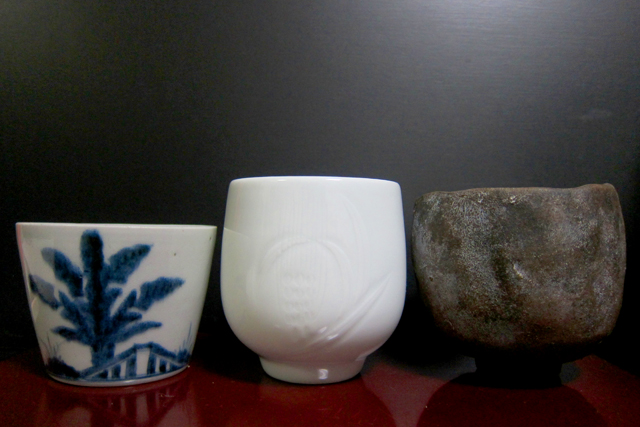2016.03.01
A discourse on drinking shochu at home ① Late Edo period soba (buckwheat) choko (sake cup), living national treasure white porcelain, falling in love with wabi (simple) color in Okinawa

I am partial to a particular brand of kokuto (brown sugar) shochu.
Drinking soba shochu at a delicious soba shop is something a young dentist turned me on to.
Barrel-aged mugi (barley) shochu is what I like these days.
There is a food connoisseur who travels around tasting various kome (rice) shochu, and I’m hoping he allows me to accompany him in the near future.
I’ve been to Kagoshima a number of times, visiting the best brewers and tasting imo (sweet potato) shochu, and have been turned on by so many new tastes I still cannot narrow them down to any favorites.
Some of the more unusual flavors were kuri (chestnut) shochu, tomato shochu, coffee shochu…?! You can have an infinite number of flavors by adding something to the second fermentation. Now that’s pretty interesting.
Compared to the variations of shochu, the world of “cups” created for drinking shochu is amazingly limited!!
Even when I scour pottery fairs and other places there isn’t even a tenth of the numbers of large sake cups or ochoko (small sake cup) and I can’t seem to find one I like. Yet when I think about the kinds of containers that could be substituted for shochu cups, there is quite a variety indeed.
Uncouth? Is it a slight to the ceramic artist? Well, I suppose that might be true. However, if you look back upon the history of earthenware, the “chawan” (rice bowl) was originally for drinking tea, and that is why there is a “cha” (tea) in the name. Furthermore, nine out of ten times when you refer to a “chawan” in Japan, it is assumed you are talking about a container you use for rice. One famous restaurant openly uses a lipped cup to serve delicious stewed vegetables. Even if I were to drink shochu from a soba cup or a tea cup, I’m sure I wouldn’t be punished… probably.
Photo to left, “Soba choko” from the late Edo period.
A musa basjoo (banana tree) and bridge have been painted on the cup and considering the period in which it was created, it leads me to believe that it must have been a very high-class design during the time. There is no other antique cup as perfect in size and shape as this soba choko. That it is “porcelain” is another good aspect. It is a cup that has transcended time for use as everyday ware. It makes me want to drink soba shochu (though I often use it to drink imo and mugi, too). In the summer when I eat cold soba noodles, it of course assumes its “designated duty” as a soba cup. It wouldn’t hurt for you to own one of these.
Center, Living national treasure of white porcelain by Yorozu Inoue.
You can probably tell from the general look of it that this is a tea cup. In other words, a cup for drinking sen-cha. I’m not sure how much you can tell by the photo, but it bears a mysterious, glossy “transparency” that is truly, truly beautiful. On the outer surface is carved a pattern of ears of wheat. Yes. Perfect for smooth mugi shochu. It was my belief that the major difference between tea cups and shochu cups could be found in the foot. The foot is elegantly tapered, but the contour may prove a bit tricky for someone who’s drunk and less than sure-handed.
Right, Free cup purchased in Okinawa.
A very good-natured writer that I will refer to as “K” frequents a certain pottery studio in Okinawa creating these. He himself calls them “free cups”, so it is with his authorization that you are free to use the cup in any way you please. Whether it is used to drink tea or to drink sake, or even to drink kale juice, the decision is left to the free will of the person who will drink from it. Convenient. The comfort of soil and the rustic texture. It is in no way the work of a renowned craftsman. However, this is actually one of my most favorite among my collection of shochu cups. Drinking oyuwari (shochu mixed with hot water) from it is absolutely the best. Although, I admit I haven’t yet tried drinking kale juice from it yet.
A discourse on drinking shochu at home② Cont’d






